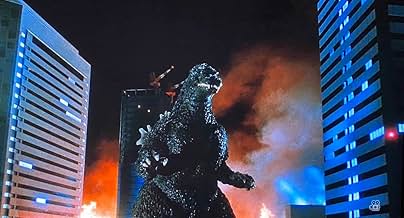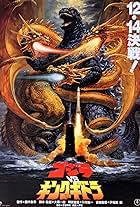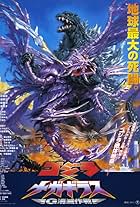IMDb RATING
6.5/10
7.2K
YOUR RATING
Desolate by the loss of his daughter, a geneticist creates a monstrous new mutation.Desolate by the loss of his daughter, a geneticist creates a monstrous new mutation.Desolate by the loss of his daughter, a geneticist creates a monstrous new mutation.
- Awards
- 2 wins
Kôsuke Toyohara
- Osamu Amesawa
- (as Kosuke Toyohara)
Storyline
Did you know
- TriviaWas voted the best Godzilla movie by fans in a 2014 Japanese fan poll. Ironically, its original release was not a success. The film had a reported $10.7 million budget making it not only the most expensive Godzilla film up until that point, but also one of the most expensive live-action Japanese films made at the time. Middling box offices results lead the studio to rethink their handling of the property and, in order to please fans, began re-incorporating classic (and therefore more marketable) monsters and stories into the following films instead of creating new ones. Toho would also begin to reduce the time and budget spent on subsequent Heisei films.
- GoofsAfter Shiragami is briefly interviewed by the media, Biollante is shown for a brief second appearing regular, but in the very next shot with Biollante, it's fully blossomed.
- Quotes
Dr. Shiragami: Godzilla and Biollante aren't monsters. It's the unscrupulous scientists who create them that are monsters.
- Alternate versionsDeleted scenes:
- When Godzilla comes ashore at Abarishi, a scene of him walking past a lighthouse and smashing it with his tail was cut.
- After Godzilla's first confrontation with Biollante in Lake Ashino, which is set ablaze by Godzilla's radioactive breath, spores from the plant creature shower the surrounding countryside causing flowers to suddenly bloom.
- Originally Godzilla was to attack the Kansai Airport in Osaka, which was under construction at the time of filming, but permission could not be obtained. Instead, Godzilla and Miki engage in a telepathic battle near a heliport for the site in the Ise Channel.
- A discarded concept was to have Biollante attempt to physically absorb Godzilla during the climactic battle. This was scrapped due to time and budgetary considerations but was the concept was visualized for the climax of 'Godzilla 2000'.
- ConnectionsEdited from The Return of Godzilla (1984)
Featured review
Godzilla vs. Biollante is a decent entry in the Godzilla franchise, particularly within the Heisei era. Surprisingly, for a sequel, it delves into the aftermath of a giant monster attack, exploring how the world grapples with Godzilla's existence. International corporations scramble for Godzilla cells, hoping to harness their power for their own gain. A fictional Middle Eastern nation, Saradia, seeks to weaponize these cells to create vegetation in their desert, while the American company Bio-Major resorts to terrorism to acquire them for a project to neutralize nuclear threats. Somehow, a giant rose monster emerges from all of this, only to be incinerated by Godzilla's atomic breath.
The plot is refreshingly complex, but the characters are forgettable. Their scenes feel disjointed, offering little backstory or development. Even the scientist who creates Biollante faces no consequences for his actions. The storytelling feels like watching an episode of a monster-of-the-week television show, where character arcs are secondary to the action. This episodic quality creates a strange listlessness, where characters change their minds on a whim and arguments have no weight. It's as if the narrative forgets about itself at times, with characters seemingly unaware of the giant monster battle happening nearby.
Despite its flaws, Godzilla vs. Biollante boasts some impressive visuals. The miniature effects, showcasing Godzilla amidst real-world locations, are well-done considering the film's reduced budget compared to its predecessor. The setting for the first Godzilla-Biollante fight is particularly striking, resembling an arena shrouded in fog with spotlights reaching towards the sky. There's a strange beauty to Godzilla movies, evident in the scene where Biollante explodes into glowing spores drifting towards the heavens.
It's almost a miracle these films work at all, considering their rapid production schedules and studio interference. Biollante even features a somewhat self-aware portrayal of humanity's anti-Godzilla strategies. The JSDF attempts to predict Godzilla's movements with the help of psychics and even hatches a plan to lure him into a zone rigged with lightning attacks. The military's monitoring of Godzilla's advance on transparent maps feels almost reminiscent of Evangelion. There's also a team of soldiers tasked with deploying bacteria engineered from Godzilla cells to consume radioactive material. One scene has a soldier firing a bio-warfare RPG from a destroyed office window - a bizarre but oddly captivating moment that injects the fantastic into the mundane. However, this soldier then inexplicably fails to escape the collapsing building, leaving his demise confusing and unearned.
Godzilla vs. Biollante is a film brimming with ideas - psychics, genetic engineering, corporate espionage - that never quite coalesce into a cohesive whole. The titular battle feels disconnected from the narrative, ultimately failing to deliver on the film's intended metaphor. This isn't necessarily a bad thing, however, as the original Godzilla metaphor itself is somewhat generic. Biollante offers a unique addition to the Godzilla bestiary - a monstrous rose, a mockery of its enemy with its otherworldly crocodile jaws. The film excels in depicting the chaos of a city preparing for a Godzilla attack, with construction vehicles working alongside tanks and soldiers. There's a sense of purpose in their actions, unlike the static defenses of previous films. Biollante is an improvement over its predecessor, but stumbles in its lack of a focused narrative. That being said, it's a film with Godzilla fighting a giant bio-engineered rose, and that's reason enough for most monster movie fans to enjoy it.
6.175/10.
The plot is refreshingly complex, but the characters are forgettable. Their scenes feel disjointed, offering little backstory or development. Even the scientist who creates Biollante faces no consequences for his actions. The storytelling feels like watching an episode of a monster-of-the-week television show, where character arcs are secondary to the action. This episodic quality creates a strange listlessness, where characters change their minds on a whim and arguments have no weight. It's as if the narrative forgets about itself at times, with characters seemingly unaware of the giant monster battle happening nearby.
Despite its flaws, Godzilla vs. Biollante boasts some impressive visuals. The miniature effects, showcasing Godzilla amidst real-world locations, are well-done considering the film's reduced budget compared to its predecessor. The setting for the first Godzilla-Biollante fight is particularly striking, resembling an arena shrouded in fog with spotlights reaching towards the sky. There's a strange beauty to Godzilla movies, evident in the scene where Biollante explodes into glowing spores drifting towards the heavens.
It's almost a miracle these films work at all, considering their rapid production schedules and studio interference. Biollante even features a somewhat self-aware portrayal of humanity's anti-Godzilla strategies. The JSDF attempts to predict Godzilla's movements with the help of psychics and even hatches a plan to lure him into a zone rigged with lightning attacks. The military's monitoring of Godzilla's advance on transparent maps feels almost reminiscent of Evangelion. There's also a team of soldiers tasked with deploying bacteria engineered from Godzilla cells to consume radioactive material. One scene has a soldier firing a bio-warfare RPG from a destroyed office window - a bizarre but oddly captivating moment that injects the fantastic into the mundane. However, this soldier then inexplicably fails to escape the collapsing building, leaving his demise confusing and unearned.
Godzilla vs. Biollante is a film brimming with ideas - psychics, genetic engineering, corporate espionage - that never quite coalesce into a cohesive whole. The titular battle feels disconnected from the narrative, ultimately failing to deliver on the film's intended metaphor. This isn't necessarily a bad thing, however, as the original Godzilla metaphor itself is somewhat generic. Biollante offers a unique addition to the Godzilla bestiary - a monstrous rose, a mockery of its enemy with its otherworldly crocodile jaws. The film excels in depicting the chaos of a city preparing for a Godzilla attack, with construction vehicles working alongside tanks and soldiers. There's a sense of purpose in their actions, unlike the static defenses of previous films. Biollante is an improvement over its predecessor, but stumbles in its lack of a focused narrative. That being said, it's a film with Godzilla fighting a giant bio-engineered rose, and that's reason enough for most monster movie fans to enjoy it.
6.175/10.
- visualsbyalan
- Mar 16, 2024
- Permalink
Details
Box office
- Budget
- $5,000,000 (estimated)
Contribute to this page
Suggest an edit or add missing content

Top Gap
By what name was Godzilla vs. Biollante (1989) officially released in India in English?
Answer
























